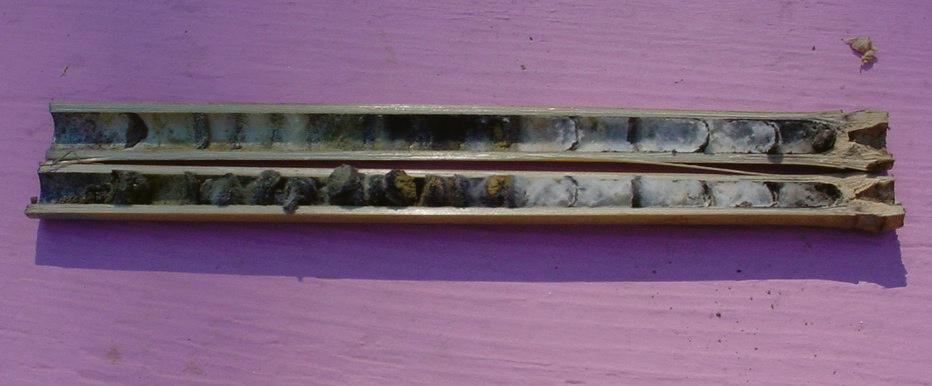The single most destructive disease of cavity-nesting bees is the fungal pathogen chalkbrood. Several chalkbrood species exist, including Ascosphaera torchioi (affecting mason bees), A. larvis, and A. aggrerata (both affecting the alfalfa leafcutter bee). These pathogens are different from the chalkbrood disease affecting honey bees (Ascophaera apis).

Chalkbrood kills the bee by infecting the gut where it competes with the larva for food, resulting in starvation. As the disease progresses, a fungal mass (called mycelium), consisting of individual filaments (called hyphae) are produced. They penetrate the gut wall, and consume the remainder of the larval body. At the end of the individual hyphae, spores are produced in a sack-like structure called an asci.
These spore-filled asci often remain just below the skin surface of the infested cadaver, and along with the mycelial mass, give the dead larva a chalky, discolored appearance ranging from brown to grey, black, or white—depending on the stage of fungal development (Figure A.19).
Chalkbrood fungi are related to many common plant pathogens such as apple scab (Venturia inaequalis) and powdery mildews. As with those plant diseases, chalkbrood spores are common in the environment and may be picked up from flowers by adult bees while foraging. As those adults return to the nest, the spores may contaminate the pollen-nectar provision. Larvae consume those spores, which germinate inside the gut. The disease cycle is further compounded when emerging bees chew through those contaminated nest cells and cadavers (which may contain millions of spores) while exiting the nest. Those emerging bees in turn provision new cells, which are also contaminated with the disease. The resulting epidemic can produce dramatic losses, and leafcutter beekeepers in the Pacific Northwest have routinely seen population losses in excess of 50 percent. Because of this disease, most leafcutter bee production has shifted to Canada where disease pressure is lower and treatments that are not permitted in the US (such as paraformaldehyde fumigation) are allowed.
The only effective control measure for chalkbrood in the US is constant, vigilant sanitation! Nest materials for leafcutter and mason bees should be phased out annually. Previously used nest materials should not be used unless thoroughly disinfected by submerging in a bleach-water solution (1:3 by volume) for five minutes. Wood nesting materials can also be sanitized by kiln drying in small lumber kilns.
Loose-cell management has been touted as an effective method of controlling chalkbrood, and the process does facilitate annual nest block cleaning. However, infected cells that are tumbled with clean cells also have the potential to spread spores. To combat this, some bee producers submerge cells for one minute in a bleach-water solution. If loose cells are not used, a phaseout system should be employed to prevent bees from re-nesting in the previous season’s nests. In addition, field shelters, incubation trays, and other beekeeping equipment should be cleaned annually.
Other factors can increase chalkbrood incidence. These include stress, second-generation bees, nest crowding, high moisture levels, and cool temperatures. Wherever possible these factors should be minimized. Both the leafcutter and mason bee chapters discuss these management issues.
